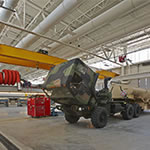The Minnesota National Guard’s new field maintenance shop, one of the largest and most modern vehicle maintenance facilities in the country, is on track to earn LEED Gold, setting an example for future military buildings.
Designed by BWBR Architects, the 107,500-square-foot building in Arden Hills, Minnesota, provides space and equipment to maintain and repair military vehicles and equipment ranging from Humvees to tanks with nearly 50,000 square feet of work bays, 20,000 square feet of storage, and 15 acres of concrete parking. “In terms of size and sustainability, it’s the first of its kind in the National Guard,” says Dennis Arntson, project manager for the Minnesota National Guard facilities management office.
As a requirement for federal funding, the project needed to achieve at least LEED Silver—the target at the outset—but National Guard leadership worked creatively with the design and construction teams to put the $25 million project on track for Gold status by its completion in May 2013. “Prior to hiring BWBR, we met with some teams early on who told us it would be difficult to achieve LEED Gold with the requirements of this type of facility given the budget, but it all came together,” Arntson says. “From start to finish, during design and construction, it’s been very successful.”
Contributing to the higher certification, the building has an inverted roof for light harvesting to illuminate the indoor spaces, which all have automatic sensors for dimming or turning off lights when sufficient daylighting is available.

The maintenance facility collects rainwater that is reused in the wash bays.
For heating and cooling the structure, the team installed 80,000 square feet of in-floor radiant heating, solar hot-water heaters, energy-efficient HVAC equipment, and heat-recovery systems.
An extensive water-collection system stores rainwater in a 25,000-gallon underground cistern for reuse in wash bays with a second 20,000-gallon tank to filter rainwater for irrigation. A direct digital control system monitors other building operations. In addition to collecting on-site water, the facility also conserves water with low-flow fixtures and a water-loop heat-pump system. It’s also set up for a future campus-wide geothermal system with an underground pipe loop.
Outside the building, the privately owned parking lot has permeable pavement to let rainwater percolate into the ground, rather than creating ditch runoff and soil erosion. The large military vehicle parking area features drainage swells and bioretention ponds, and landscaping uses low-maintenance and native plantings to soften the expanse of pavement. “We’ve reduced water runoff into the watershed by using these on-site, sustainable elements,” Arntson says. “It also reduces the impact on neighboring properties.”
The 40-kilowatt solar photovoltaic system provides 6.5 percent of the building’s electricity. Designed for max capacity of 39.9 kilowatts and 51,000 kilowatt-hours in total annual energy production, Arntson says the system is expected to achieve those numbers this year.

